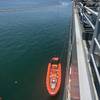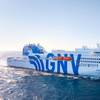USS Pampanito, visited by more than 250,000 people annually at San Francisco's Fisherman's Wharf, was placed in drydock at Bay Ship & Yacht Co., in Alameda, Calif., earlier this year for barnacle scraping, hull painting and other projects, including repairs to the torpedo tubes.
Towing services to Bay Ship & Yacht Co. were donated by SeaRiver Maritime, Inc. While in drydock, the submarine's underwater hull was inspected, cleaned and painted, and all 38 zincs ("sacrificial" nodes to protect against electrolysis) were replaced.
Additionally, Bay Ship & Yacht donated its services to paint the boat's superstructure. At a cost of $250,000, this drydocking is the most extensive overall refurbishment of the submarine since its original restoration, more than 20 years ago.
Ship Manager Richard Clark oversaw the drydock work. "Ideally, the zincs on the submarine should be replaced every couple of years," he said, "so we're devising a way for divers to replace them in the future. The work we're doing is part of our commitment to preserving Pampanito for the next 100 years, keeping our history alive for our children's children."
The 55-year-old diesel-electric submarine is one of the most popular historic vessels in the country, according to the nonprofit National Maritime Museum Association, whose revenues support the programs of San Francisco's Maritime National Historic Park. Visitors to spruced-up Pampanito will also enjoy a freshly cleaned and painted Pier 45.
The 311 ft. Balao class submarine was built at Portsmouth Naval Shipyard in New Hampshire in 1943. The normal crew complement was 10 officers and 70 enlisted men. Of the hundreds of men who served on Pampanito, about 50 are still alive. The submarine's veterans hold reunions every two years.
Pampanito made six patrols during World War II, sinking six Japanese ships and damaging four others during patrols through the South China Sea, along the coasts of Borneo and Australia, and up to Midway Island. It also escaped several enemy attacks, including at least two depth-charge attacks.
In its third, and most well-known patrol, Pampanito operated as part of a wolfpack with two other subs. On September 12, 1944, the pack attacked a convoy carrying war production materials. Unknown to the submarine skippers, the convoy also carried more than 2,000 British and Australian prisoners of war being transported to Japan, where they were to be used as forced labor in copper mines. The Japanese could have requested safe passage for the transfer of prisoners, but no such request was received. As a result, Allied submarines were unaware the ships were carrying the men.
Many of the ships in the convoy were sunk by the pack, including two ships carrying the POWs. Three days later, Pampanito returned to the area and rescued 73 British and Australian POWs at sea, who had survived the sinking. An additional 878 POWs were rescued by the Japanese and other Allied subs.
Following the war, USS Pampanito served as a training ship for the Naval Reserve before being transferred to the National Maritime Museum Association in 1976. It was mothballed at Mare Island until being opened to the public in 1982.
Subscribe for
Maritime Reporter E-News
Maritime Reporter E-News is the maritime industry's largest circulation and most authoritative ENews Service, delivered to your Email five times per week











